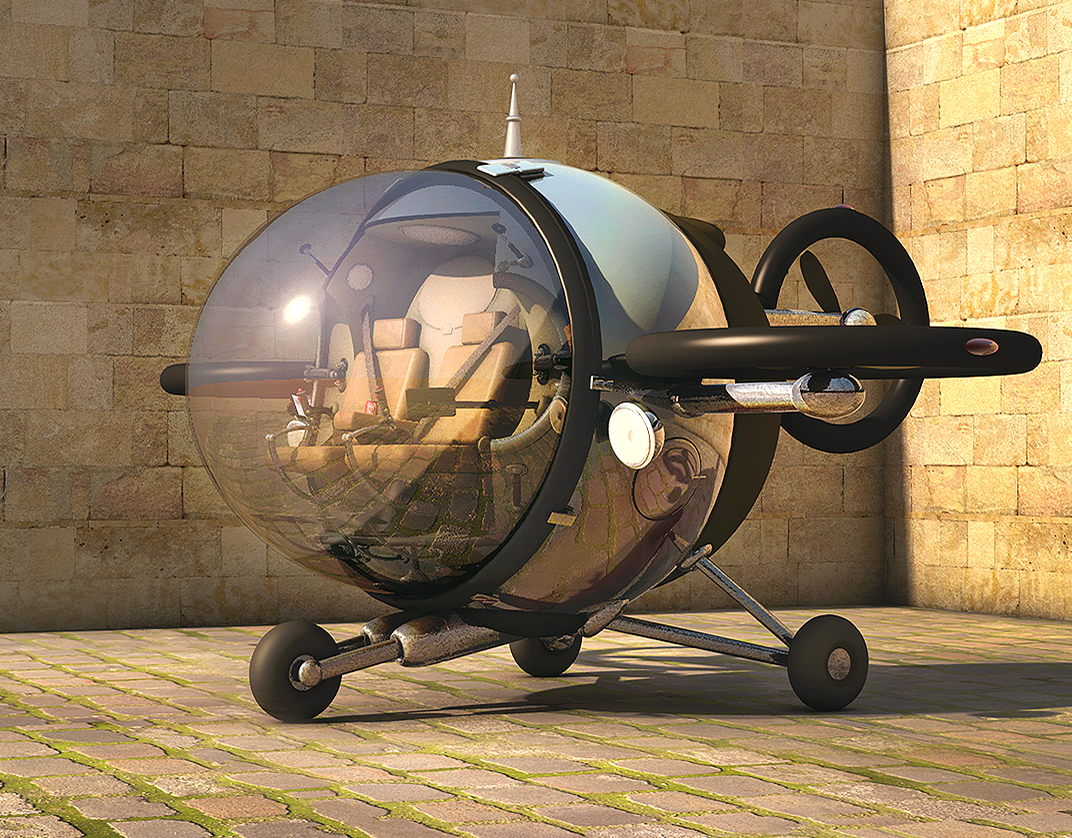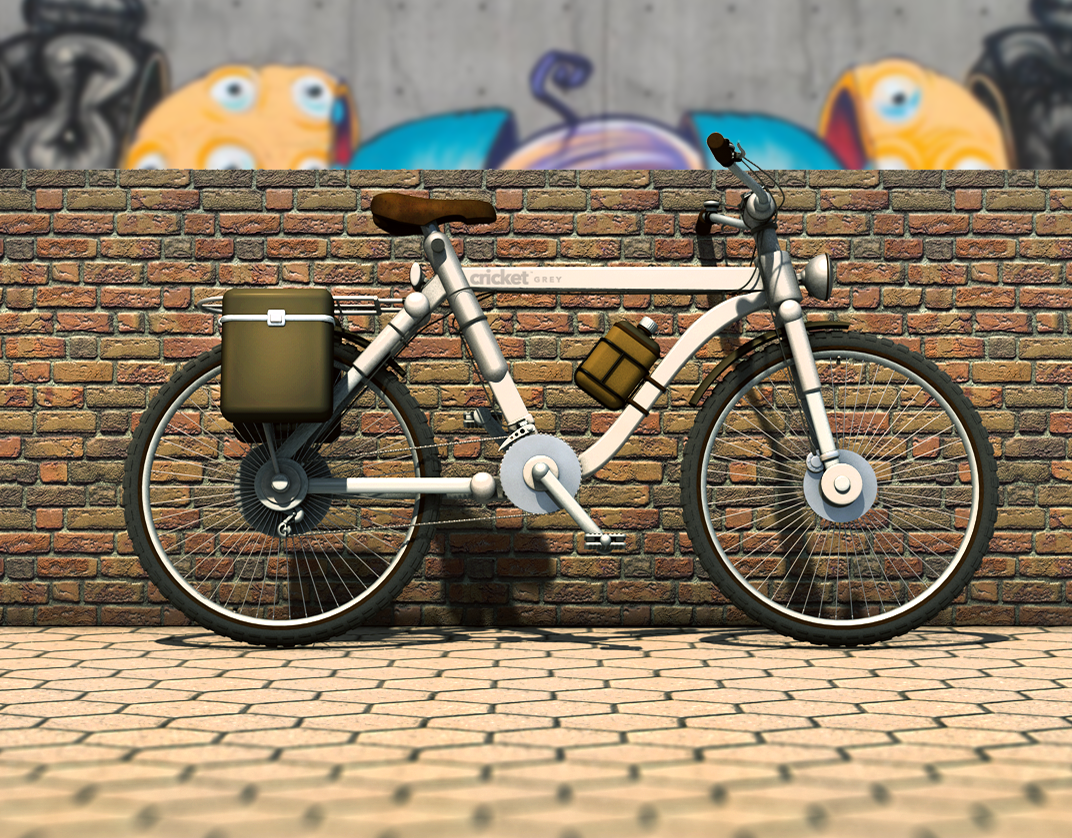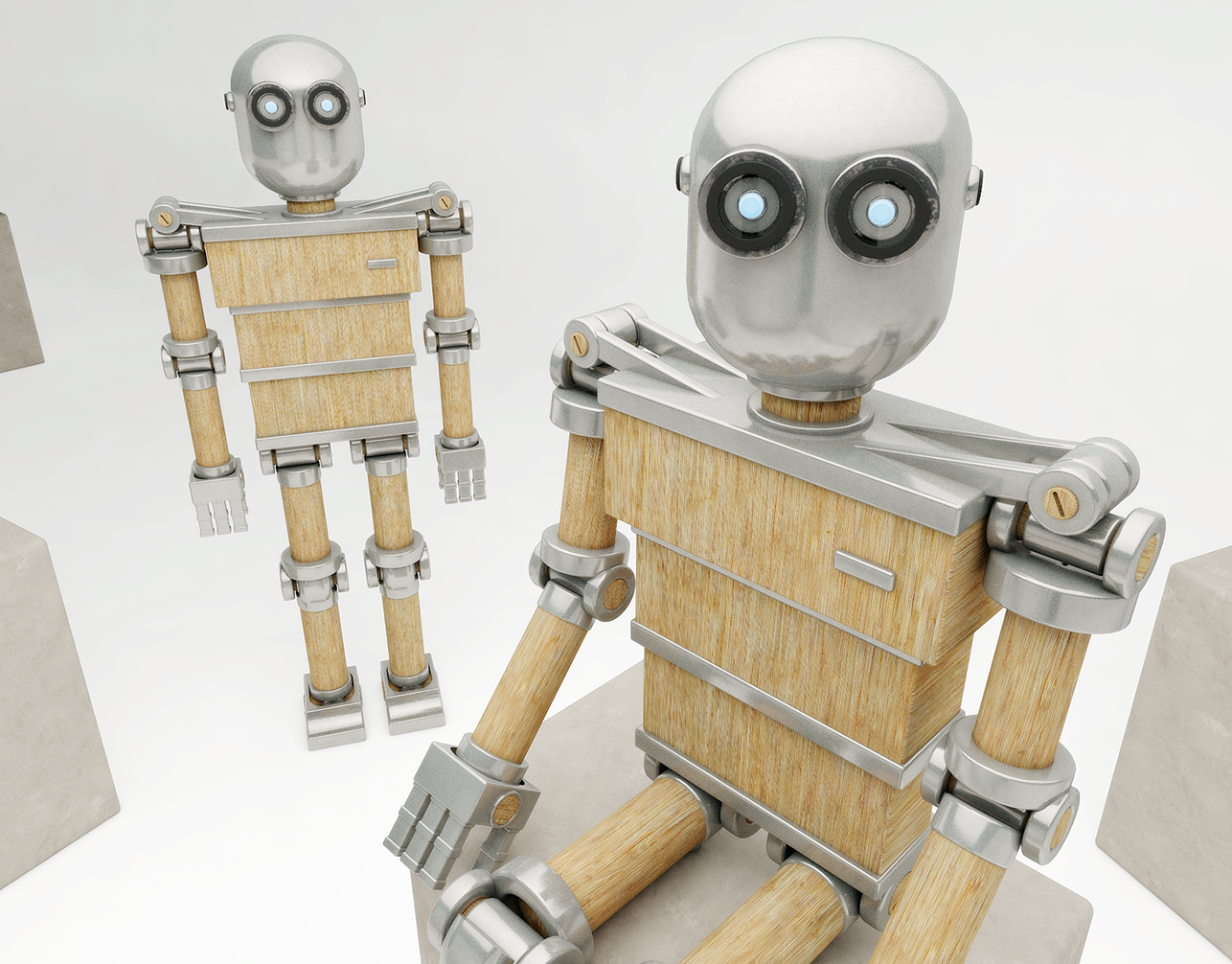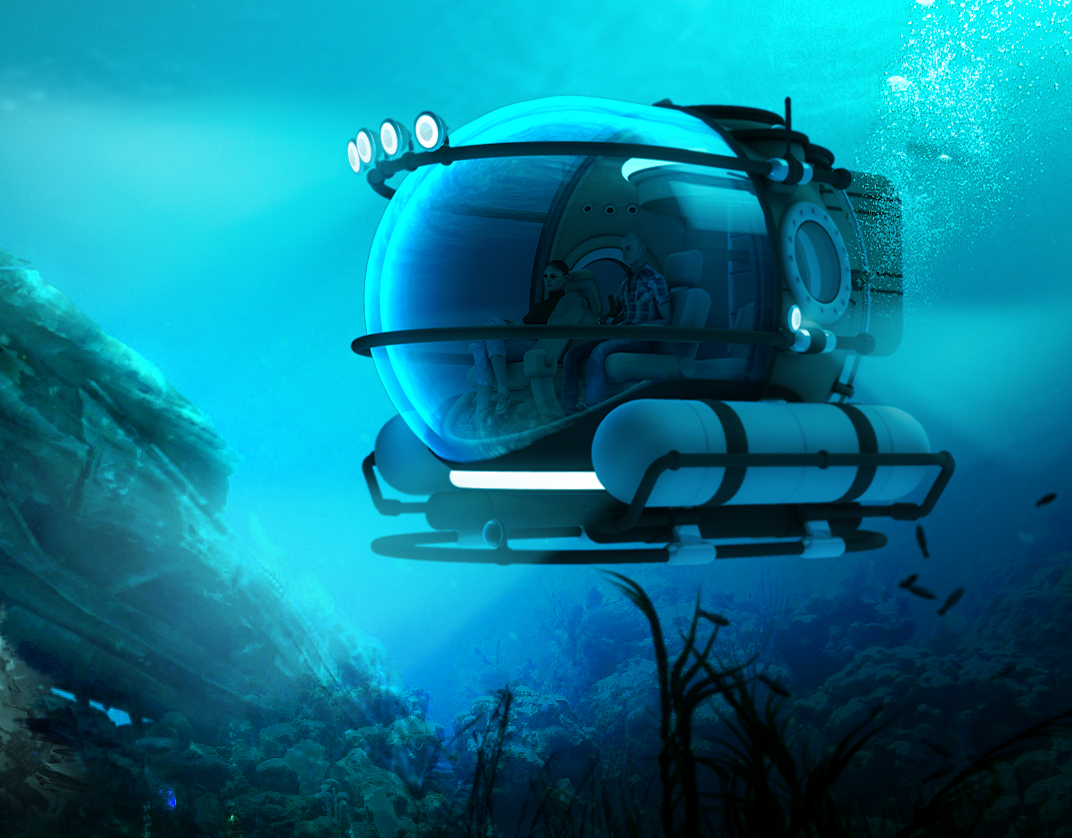Drone flying over Exo_Planet surface
Exo_Planet: Glimpses of the Outside
A Virtual Journey to Another World
©2015 Eduardo Galvani
A Virtual Journey to Another World
©2015 Eduardo Galvani
"Exo_Planet - Glimpses of the Outside" is a lyrical and visual sci-fi experience which illustrates the chronological sequence of primary steps on scientific and technological development for the human colonization of another world.
The narrative tells a fictional story, situated in a future maybe not so far, where humans have already developed safe spacecrafts in which they can travel fast enough for long times and distances into the Space to reach an habitable exoplanet.
This NASA/ESA Hubble Space Telescope image of the cluster Westerlund 2 and its surroundings has been released to celebrate Hubble’s 25th year in orbit and a quarter of a century of new discoveries, stunning images and outstanding science. Image Credit: NASA, ESA, the Hubble Heritage Team (STScI/AURA), A. Nota (ESA/STScI), and the Westerlund 2 Science Team.
THE COSMOS
For us the humans, the universe is so intriguing and mysterious as its unimaginable dimensions. Since our childhood, we use to look up to the sky at night, and while watching the moon, the planets and the stars, we think about cosmotrips, about if is there some kind of life outside the Earth and how it would be in another world.
Exo_Planet
ANOTHER WORLD
The first step of the exoplanet’s mission is to find a planet outside the Solar System which has environmental conditions similar to the Earth -- which means, essentially: the gravity strength, the atmospheric pressure and composition, the average temperature and the existence of water.
The searchings for the ideal exoplanet may take several years, and some real habitable planets were already discovered by astronomers. One of the most recently Earth sized habitable exoplanets discovered is known as Kepler 186f, which orbits an habitable zone of another star like the Sun. Kepler 186f is about 500 light-years from Earth, in the constellation Cygnus, but may be there in outer space many other habitable planets waiting to be discovered as well.
However, Alpha Centauri is the closest star system from Earth ever discovered, it has 3 stars of the same type of the Sun and is about 4,5 light-years from us. Phaethon is told one habitable planet of Alpha Centauri system, but even to travel there, because of the long distance, humanity still needs to develop further technologies for faster Space travels.
As this story represents a fictional mission, lets suppose that the ideal Space travel technologies have been already developed, as described in ‘The Mission’ chapter, and lets call the destination planet just ‘Exo_Planet’.
Indeed, the main reason and motivation for the Exo_Planet colonization is because its atmospheric conditions are very constants. Although the average atmospheric temperature, relative humidity, composition and pressure are very similar to the Earth conditions, there, only rains once a year in most regions (when it happens). The interchanges of matter and energy between the atmosphere and the soil occurs in very, very smooth and continuous flows. Exo_Planet is like a place ‘stopped in time’ when compared to the Earth. This condition is ideal for a safe development of human life and culture, because there are just minimal weather variations: no storms and floods, no vulcans, no hurricanes or strong winds, no earthquakes and no tisunamis too. So, if humans could develop technologies to cultivate and grow enough food there, they will be able to live far from many natural hazards and disasters from Earth. Depending on the biological adaptation, humans may be able to bring another species of living beings from the Earth to share the Exo_Planet life with them. Therefore, Exo_Planet would be the cradle for a new kind of human civilization based on a new reality.
The "Hope Circle"
THE "HOPE CIRCLE"
Even after developed the proper Space travel technologies, before the first tripulated mission, humans still need to know some very important informations about the Exo_Planet. Thereby, the previous researches, promoted from Earth and locally with satellites and non-tripulated spacecrafts, provided its composition, mass, geological, geographical and orbital datas, as its gravity strength and regular atmospheric conditions.
The preliminary researches also spotted ‘The Hope Circle’ -- an ancient valley located in the northern hemisphere, near from the ‘Purple Sea’ --, as the best place for landing: As theres drinking water to be extracted from the soil, it is proper for the Base Station construction and to the beginning of the human colonization process.
Furthermore, as there was a lake many time ago, the soil in this region is also proper for researches about life development, because it may be rich in minerals and different kind of organic and non-organic matter and nutrients.
Hermetic Astronaut Suit
SCIENCE AND TECHNOLOGY
After developed the safe Space travel technologies and situated the ideal destination spot on the Exo_Planet's surface, humanity still needs to develop other several technologies, methods and systems in order to proceed with a safe process of colonization.
In order to insure the safest mission as possible, these technologies, methods and systems are all developed from scientific knowledges and experiments.
Thus, even considering that the early studies revealed the Exo_Planet’s life conditions very similar to the Earth, as some possible variations of its atmospheric conditions may still remains unknown, in the first years of the colonization process, the astronaut crew needs to use special hermetic suits, which provides a permanent state of life with good quality oxygen, automatic thermo-control, keeps their bodies away from possible contaminations of strange microorganisms, their skin and eyes protected from radiations and also provides communication and remote control systems for many devices, equipments and the Base Station functions.
The next chapters describes some of the technologies and scientific knowledges used in each step of the Exo_Planet Mission, since the preconditions of the astronauts crew, their necessary skills and equipments, as the materials, components, functions and architecture of the Base Station and other essencial stuff and informations about the mission.
Spaceship Flight Trajectory
THE MISSION
The first basic equipment required for the Exo_Planet Mission is, of course, a great and safe spacecraft ready for long space travels, for the transportation of the crew and all the essencial stuff: supplies and equipments for the maintenance of life during the trip time and also for the necessary period of assembling the Base Station on the Exo_Planet surface, as well as the vehicles and equipments required for generation of food and electricity energy, extraction and filtering of air and water.
For the Exo_Planet Mission, one spaceship with two landers were used: One lander for the crew and their life maintenance structure, and another lander for transportation of extra oxygen, water and food, tools, materials and the pre-builded components of all the equipments and the Base Station structure.
The spaceship propulsion technologies are powered by Nuclear Fusion and Ion Thrusters, which allows it to keep constant acelleration for years and travels at extraordinary speeds with relatively low fuel consumption rates.
The space travel
The Lander 'A' and 3 astronauts, few days after landing.
THE CREW
The Exo_Planet Mission’s Crew has 8 members, and it was thought to be very versatile and multidisciplinar, which means a group of very smart and proactive persons, as described below:
1 Electrical Engineer
1 Chemical Engineer
1 Mechanical Engineer
1 Doctor
2 Physicists
1 Biologist
1 Philosopher
1 Chemical Engineer
1 Mechanical Engineer
1 Doctor
2 Physicists
1 Biologist
1 Philosopher
As their bodies and minds are the first essencial tools of the crew, they all have proper physical and psychological preparations for the mission:
For their bodies, they have a balanced alimentation with wide variation of nutrients and cultivates the daily habit of physical activities.
For their minds, besides the expertise knowledges of each one, they also studies Philosophy, Psychology and Anthropology for the consciousness and better understanding the importance of their mission.
The Crew
COLONIZATION METHODOLOGY
As described before, the Exo_Planet Mission uses 1 spacecraft with 2 landers. Landers are the cabins which gets apart from the spacecraft and lands on the Exo_Planet soil. Each Lander is equiped with 20 small directional jets for orbital adjustments before getting into the Exo_Planet Athmosphere, and another big jet and a parachute for a soft landing. Each Lander has a wide internal space, and both carries together all the necessary stuff for the colonization process:
Lander 'A' is the one in which the crew lands and survives provisionally for few months. Compared to the Base Station which will be constructed there, the Lander has a smaller internal space, but it still contains all the necessary structure to keep the crew safe during the first months of the mission, or to house them in case of emergency until a rescue mission be sent from Earth. Lander 'A' also transports the personal objects of the crew and their spacial hermetic suits (2 kits for each astronaut).
Lander 'B' transports extra Food, Water, Oxygen and the other necessary chemical elements for waste, water and air treatments, plant nutrition, scientific experiments and medical purposes. Lander ‘B’ also transports tool kits, LED light kits, computers, controller boards, tyres, wheels, motors, polymer sheets and tent fabrics with photovoltaic films, inflatable furnish, pumps, cables, tubes, joints, switches, controllers for water, air and light resources, heaters, coolers, balances, centrifuges, blenders and the other equipments and instruments of the laboratory, as all sort of small components made on Earth and strictly necessary for the assembling of electronic stuff and communication equipments.
Lander 'B' still transports all the components and supplies of a big and multi material 3D Printer, which works very fast with until 4 heads simultaneously, and will be assembled soon after the arrival in the Exo_Planet. So, after it is assembled, the 3D printer will then work night and day to produce the structural parts of the Base Station and all the pieces of the other Basic Equipment, as described and illustrated within the next chapters.
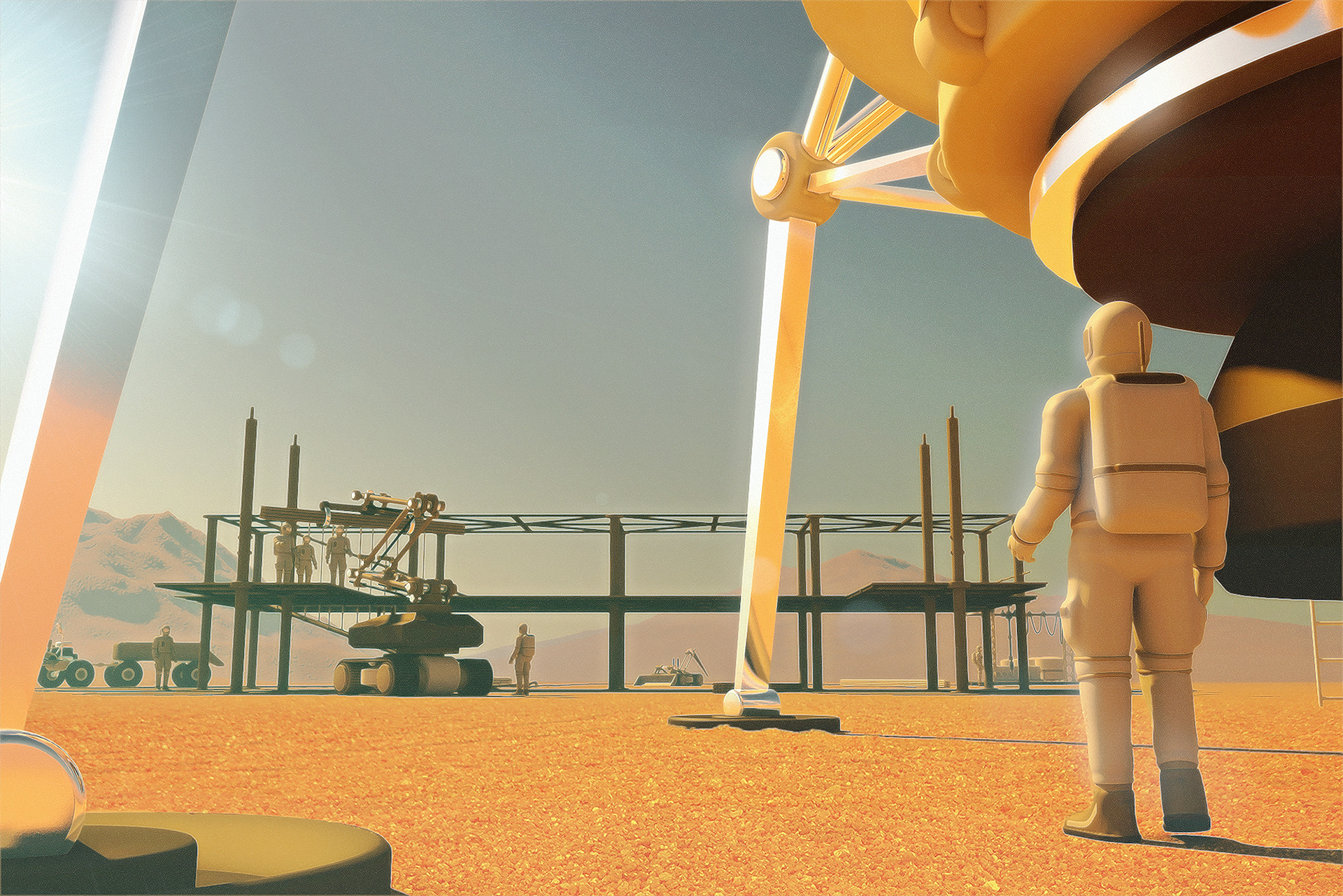
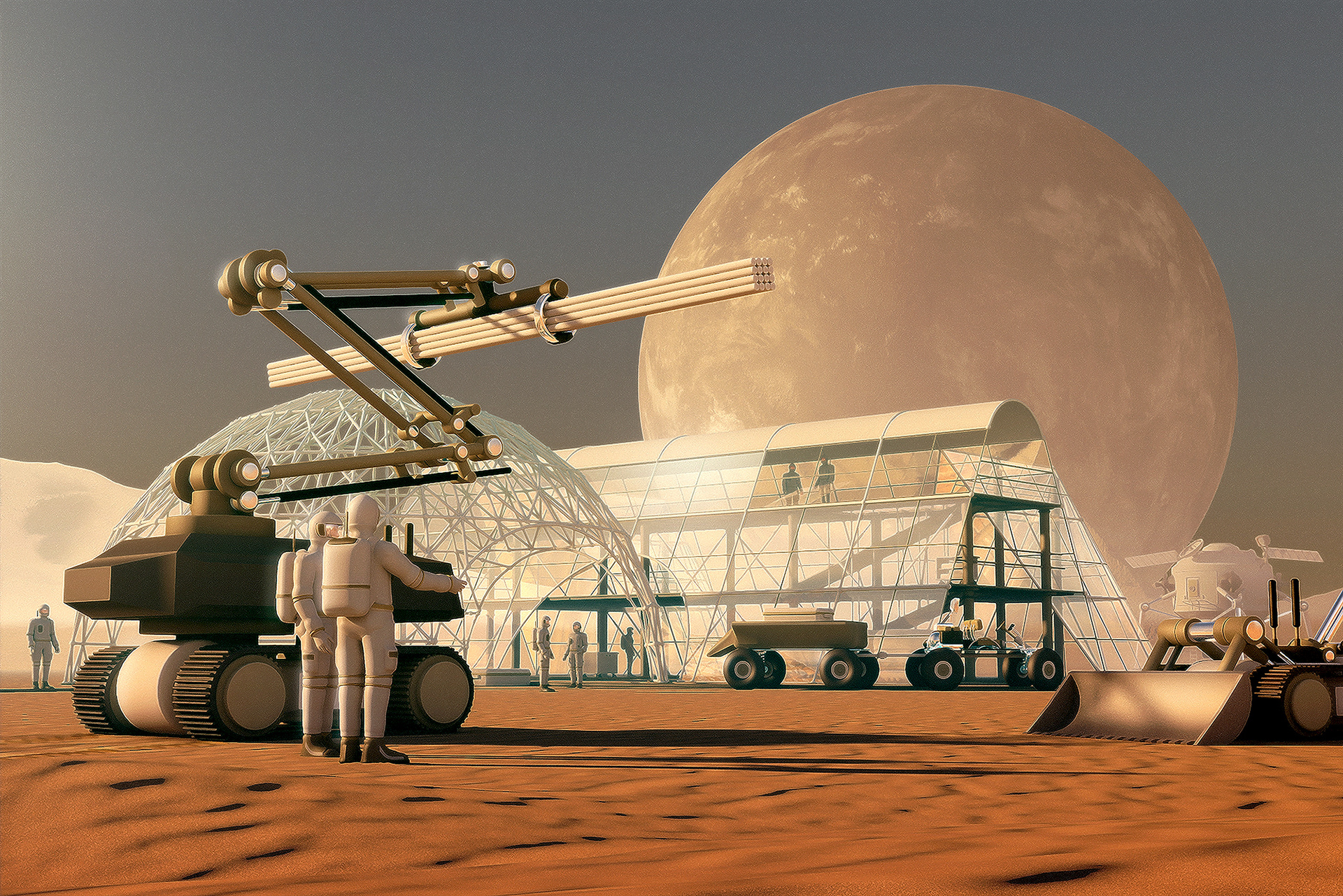
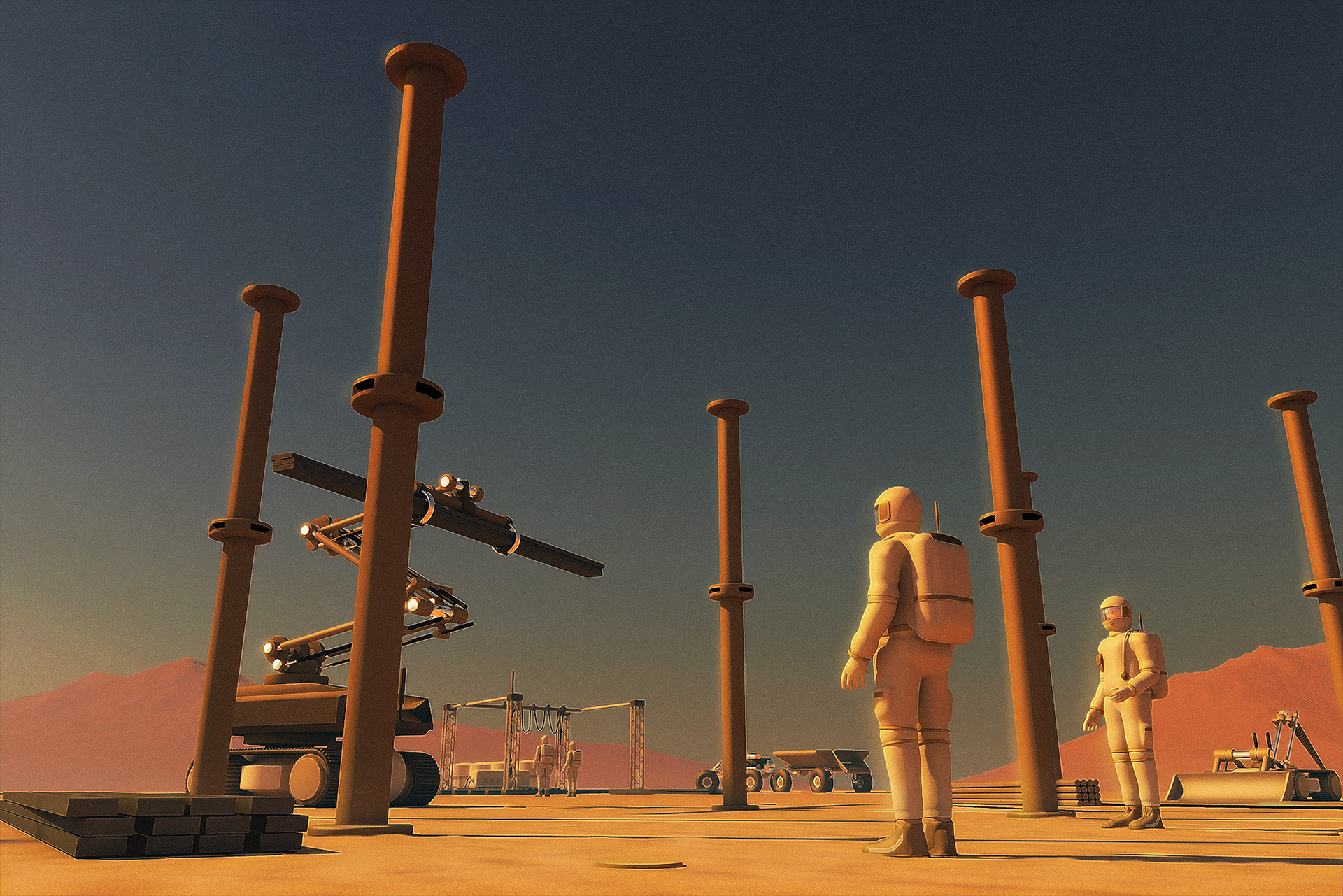
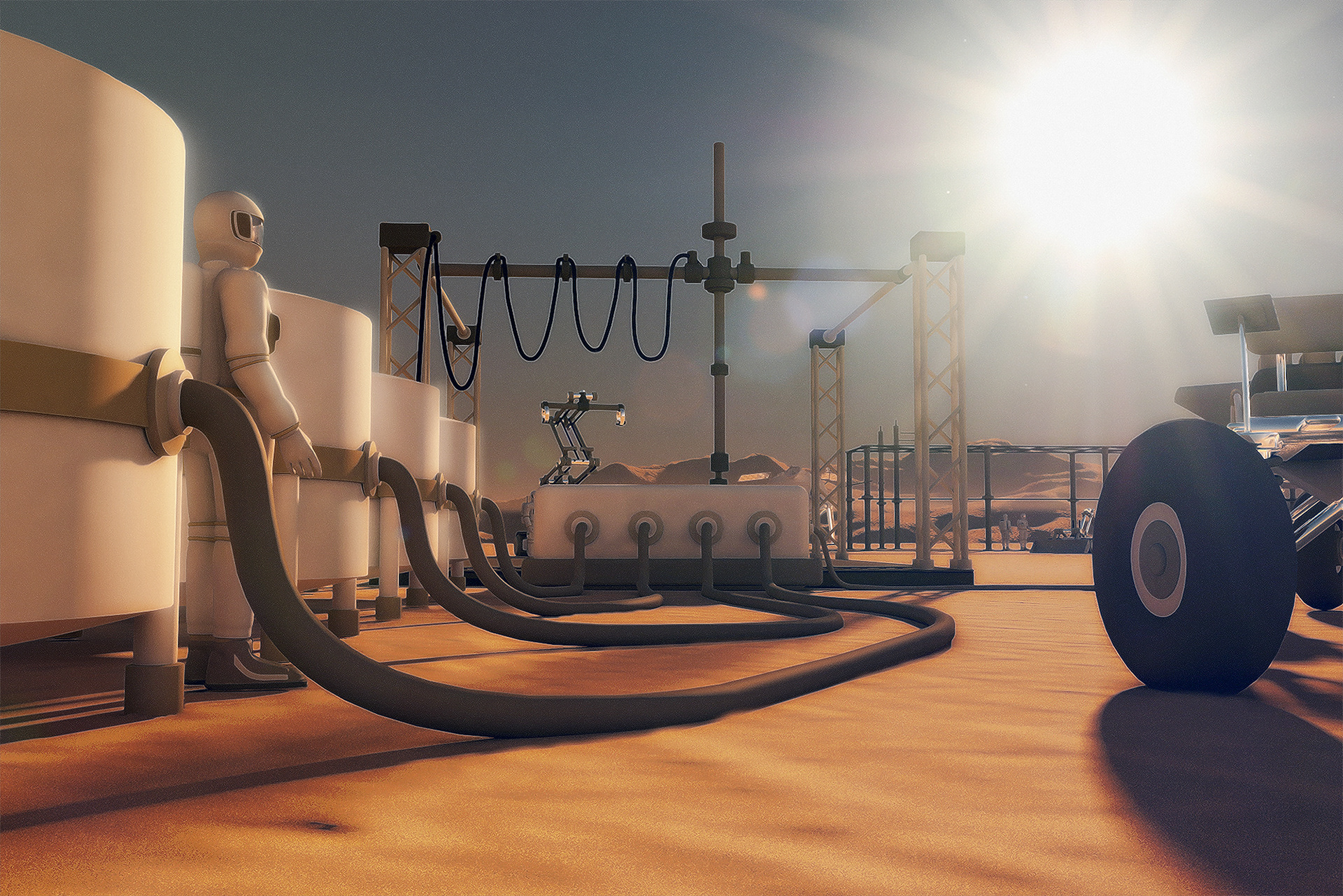
The Base Station Construction
The Base Station almost habitable
The Base Station, finally habitable, at night
BASE STATION STRUCTURE
The Base Station has 3 functional floors, with Entrance Hall, Wardrobe and Collective Closet, Vertical Hydroponic Farms, Central of Resources, Kitchen, Toilets, Storerooms, Scientific Labs, Meeting Table, Gym, Chillout Room and Dormitories. The external Garage Tent is equipped with Battery Banks, which supplies electric power for external equipments and recharging system for the autonomous vehicles.
On the first floor, the wide Entrance Hall provides a free space where the astronauts are able to work with easy flow between functions of the Vertical Hydroponic Farms and on maintenance of the Base Station structure and the other equipments. The Kitchen is equipped with all necessary stuff for food storage and preparation, and with a wide table for the meals.
With mushrooms, fruits and vegetables well selected, the Vertical Hydroponic Farms provides food, organic ambientation, green visuals and also helps control the internal atmospheric conditions.
As the Vertical Hydroponic Farms structure are reusable for many years, at each cycle of harvesting, some part of the food are processed and stored for further meals, so if well administrated, the rich variety of organic food can be unlimited. The Wardrobe holds the astronaut’s helmets and boots, while the Closet holds and recharges their suits and bags. The Storeroom holds processed food, medical resources and all sort of materials, small tools, instruments and equipments. The Toilet rooms are also equipped with lavatories and warm showers.
On the second floor, the Scientific Lab has all the necessary instruments for researches: Conference Table, Work Tables, Tablets, Desktop and Laptop Computers, Electronic Field Microscopes, Magnifiers, Balances, Blenders, Heaters, Coolers, Centrifuges and all sort of utensils for physics, chemistry, biology and mineralogy researches. The Gym allows everyday exercices, and the Chillout Room -- with sofa, table and an analogic telescope for amateur space observations -- provides a comfortable life time.
On the third floor, the Collective Dormitory stimulates the familiarity and the biological co-adaptation between the crew members. The individual Bed Stations and Suitcases provides temporal isolation and independent storage for their personal objects and clothes.
The Base Station
BASE STATION ARCHITECTURE
The Base Station is a safe and strong building, designed for very practical and fast assembling: all its beams were developed with special internal geometric forms to provide quite strength with low density. Most of its parts are generated with the multi material 3D printer from a selection of special materials: Carbon, Titanium and Aluminium for the beams and joints, Carbon Fiber for the floors and the roof.
Even that the Exo_Planet weather is very stable and constant, the Base Station shapes and materials were thought to be very safe in any environmental conditions, such as strong winds and quick huge variations of temperature: All the walls were drawn with angles or bends to reduce the wind impact, to provide a better use of natural light, to absorb more energy on its photovoltaic cells, and to self-clean its surfaces with ease when it eventually receives water from the rain.
The LED light spots and the air ducts were well distributed in order to optimize the use of these resources and to keep the Base Station the most comfortable as possible. The Central of Resources (with waste/air/water filters, electricity generators and battery banks) warranties the maintenance of electricity, water and oxygen extracted from natural resources. The automatic Air Filters does the maintenance of the internal atmospheric conditions by providing the ideal temperature (68ºF average), pressure, relative humidity and the equilibrium between the CO2 and O2 levels with a filtering process that artificially generates phisical-chemical functions to isolate and treat these elements.
Entrance Hall
Kitchen/Refectory
Kitchen/Refectory
Meeting Table
Chillout Room
LAB
GYM
Dormitory
Dormitory
BASIC EQUIPMENTS
The Exo_Planet Mission is supported by very important equipments:
A big and fast Multimaterial 3D Printer, for printing all sort of pieces necessary on the Base Station and on the other equipments assembling; A versatile electric Space Car with Cart, for generic transportations; A Multifunction Bulldozer, for all kind of terrain works; An Antenna Car, for interplanetary communications; A Drone, for environment explorations; A Crane, for heavy works; An Auger, for soil perforations; The EEGS (Electric Energy Generation System), with a Photovoltaic Heliotropic “Sunflower” and 3 Wind Turbine Towers; A Filter/Boiler with O2/H2O treatment systems and complementary electricity energy generator; 2 Silos, for O2/H2O storage; And the Base Station itself, with Photovoltaic Surfaces, Biomass Filter/Treatment system, Battery Banks, Electric Energy Generator Systems and its functional internal structures.
Basic Mission's Inventory
EXO_PLANET LIFE
Besides the ‘Scientific and Technological Research Calendars’, there is also the ‘Everyday Calendar’ which orients the crew in their daily life, so, beyond their specialized practices, all the astronauts acts in varied other functions, as cooking, maintenance of the equipments and structures, plantations, and more.
As described within the early chapters, one of the main criteria on the Exo_Planet selection for the colonization process was its atmosphere conditions, which is a bit different in some ways, but very similar to the Earth in another aspects, as it may allows the existence of water and organic structures in the same ways as we know here. So the 'Research Calendars' includes studies about chemical and physical behavior of elements, molecules and materials, organic and non-organic structures in the Exo_Planet atmospheric conditions: For this, the astronaut crew promotes regular inductions and evaluations of chemical reactions, gravity and physical simulations with different compounds and elements of the classical periodic table from Earth, and with new physicochemical compounds and elements extracted by local mineralogy from the Exo_Planet atmosphere and soil.
The studies are all categorized, and the results are set in tables, then compared between them according to the correspondent categories for a better understanding of the chemical and physical behaviors and conditions of the Exo_Planet. These studies are important because may reveal new kinds of chemical elements, molecules and materials, physicochemical reactions, and, by consequence, may also reveal new usable elements, compounds and materials, as new kinds of possible life forms.
The crew also promotes studies about quantum physics, subatomic particles, light and sound propagation, including infra and ultra frequencies, and about how different kinds of vegetables, bacterias, viruses and fungi grows and reproduces within the Exo_Planet atmospheric conditions.
During the first decades of the colonization process, at each interval of three years, another mission arrives from Earth on the Exo_Planet surface bringing new stuff from Earth, like Chemical Elements, Seeds, Materials, Electronic Components, Personal Objects and other stuff.
Recharging Vechicles
Vertical Hydroponic Farm
Vertical Hydroponic Farm
Base Station Aerial Drone View
Base Station view
Base Station Aerial Drone View
"Purple Sea" exploration
GLOSSARY
ANAEROBIC 1. (of an organism or tissue) living in the absence of air or free oxygen. 2. pertaining to or caused by the absence of oxygen.
ATMOSPHERE A layer of gases surrounding a planet or other material body of sufficient mass that is held in place by the gravity of the body.
BIODIGESTER The conversion of biodegradable waste matter into compost in the absence of oxygen (anaerobic digester).
BIOMASS Biological material derived from living, or recently living organisms.
COSMOS The universe regarded as an orderly, harmonious whole.
ELECTROLYSIS A technique that uses a direct electric current (DC) to drive an otherwise non-spontaneous chemical reaction.
EXOPLANET An extrasolar planet.
GRAVITY Gravity (or gravitation) is a natural phenomenon by which all things attract one another including stars, planets, galaxies and even light and sub-atomic particles.
HELIOTROPIC Turning or growing toward the light, esp. sunlight. Heliotropism is a form of tropism, the diurnal motion or seasonal motion of plant parts (flowers or leaves) in response to the direction of the sun.
HYDROPONIC is a subset of hydroculture and is a method of growing plants using mineral nutrient solutions, in water, without needing of soil.
ION THRUSTER An ion thruster is a form of electric propulsion used for spacecraft propulsion that creates thrust by accelerating ions.
LED A Light-Emitting Diode (LED) is a two-lead semiconductor light source. It is a p–n junction diode, which emits light when activated.
MOLECULE An electrically neutral group of two or more atoms held together by chemical bonds.
ORGANIC Matter that has come from a once-living organism, is capable of decay or the product of decay, or is composed of organic compounds.
POLYMER A large molecule, or macromolecule, composed of many repeated subunits.
PHOTOVOLTAIC Capable of producing a voltage when exposed to radiant energy, especially light.
OUTER SPACE Outer space, or just space, is the void that exists between celestial bodies, including the Earth. It is not completely empty, but consists of a hard vacuum containing a low density of particles, predominantly a plasma of hydrogen and helium as well as electromagnetic radiation, magnetic fields, neutrinos, dust and cosmic rays.
THERMOCONTROL The use of various temperature monitoring devices and cooling methods, such as forced air flow, within a processor or FPGA-based system, to control overall temperature of ICs and internal cabinet temperatures.
Reviews
"With martian movies smashing the box office and NASA’s recent announcement to put permanent residents on Mars the big news, space colonization seems like all the rage right now!"
Yanko Design

